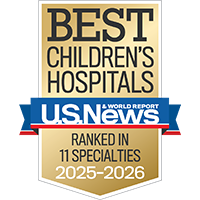Feeling at home
From bedside bingo to therapy dogs, we're here to help kids smile and feel more like themselves.
Visit Child Life services

Infantile spasms are a type of seizure linked to an epilepsy disorder called West syndrome, or infantile epileptic spasms syndrome. These seizures occur in the first year of a child's life, usually when they're between 4 and 8 months old.
The spasms feature a sudden bending forward of the body, with the arms and legs becoming stiff for a second or two. They usually happen right after the baby wakes up and often come one after another in clusters lasting several minutes. A baby can have hundreds of these seizures in a day.
Infantile spasms usually stop by the time the child is 4 or 5 years old. But more than half of children who experience infantile spasms develop other types of epilepsy, such as Lennox-Gastaut syndrome, a severe seizure disorder that typically begins by age 4. Children with infantile spasms also have a higher risk of autism.
Early diagnosis and treatment are crucial because infantile spasms can seriously impact brain development. Children who were developing normally before the condition's onset tend to have better outcomes. Yet early treatment can improve outcomes even for babies who had developmental issues before their spasms began.
The Pediatric Epilepsy Program specializes in caring for kids with epilepsy, including infantile spasms. Our team includes pediatric epileptologists (neurologists with advanced training in epilepsy), pediatric neurosurgeons and child psychiatrists, all of whom are highly skilled in treating early-onset epilepsy, tough-to-manage seizure disorders and rare types of epilepsy. We are recognized as a level 4 care center (the top accreditation level) by the National Association of Epilepsy Centers. Our patients have access to the latest therapies and support services, such as child psychology and special education. They also may have the opportunity to take part in clinical trials on promising treatments for pediatric epilepsy. Learn more about the process and benefits of participating in a clinical trial.

Ranked among the nation's best in 11 specialties

One of the nation's best for neurology & neurosurgery

in NIH funding among U.S. neurology programs

Accredited level 4 epilepsy center (National Association of Epilepsy Centers)
Two out of three babies who experience infantile spasms have an identifiable cause for their seizures. These may include:
Infantile spasms are not linked to family history, a baby's gender or immunizations.
Infantile spasms may be subtle and are sometimes confused with normal baby behaviors, such as hiccups, colic or the startle reflex. However, none of these occur in clusters the way infantile spasms do.
Infantile spasms are a distinct type of seizure that may have the following features:
Over time, the child may also show less interest in their surroundings or in social interaction. The seizures lead to a halt in development, affecting skills such as sitting, rolling over or babbling.
Diagnosis of infantile spasms is usually done by a pediatric neurologist – a doctor who specializes in the brain, spine and nervous system of children. The diagnostic process may include:
Treatment for infantile spasms depends on the underlying cause of the seizures. For some children, medication works; some may be helped by a special diet; while others may need surgery to control their seizures. Early treatment with the most effective therapies is essential for minimizing the long-term consequences of the spasms.
The first line of treatment is typically anti-seizure medications, including:
If your child is on a medicine-based treatment for infantile spasms and it doesn't seem to be working, please see a pediatric epilepsy specialist as soon as possible. They can help you figure out a better treatment plan moving forward.
Surgery may be the best treatment option for children whose seizures occur in a specific area of the brain and have a distinct effect, such as when the infant turns their head or their eyes to one side and back. In children with these types of spasms, EEGs are less likely to show the pattern of brain electrical activity typically associated with infantile spasms.
The ketogenic diet prescribed for epilepsy – which is high in fat and very low in carbohydrates – has been reported to be a safe, easy-to-manage feeding plan that may work to treat babies with infantile spasms when ACTH, other steroids and vigabatrin have failed to help.
This information is for educational purposes only and is not intended to replace the advice of your child's doctor or other health care provider. We encourage you to discuss any questions or concerns you may have with your child's provider.
Feeling at home
